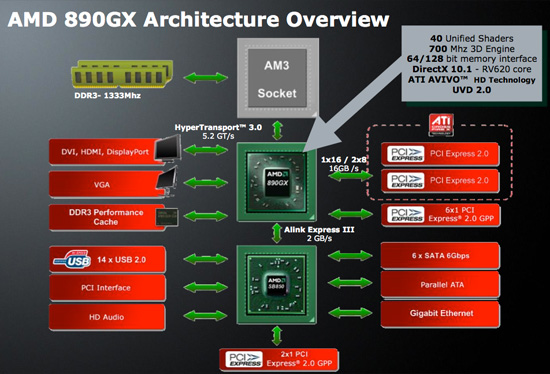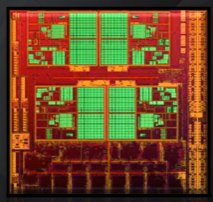AMD's 890GX Chipset - Same Graphics, Better South Bridge
by Anand Lal Shimpi on March 2, 2010 4:36 AM EST- Posted in
- CPUs
No news isn’t always good news. AMD has been purposefully vague on the graphics specifications of its 8-series chipsets. Today we know why. The AMD 890GX has the exact same graphics horsepower as the 790GX:
| AMD 890GX | AMD 790GX | AMD 785G | |
| CPU | AMD Socket-AM3 | AMD Socket-AM3/AM2+ | AMD Socket-AM3/AM2+ |
| Manufacturing Process | 55nm | 55nm | 55nm |
| PCI Express | 24 PCIe 2.0 lanes | 22 PCIe 2.0 lanes | 22 PCIe 2.0 lanes |
| Graphics | Radeon HD 4290 (DirectX 10.1) | Radeon HD 3300 (DirectX 10.0) | Radeon HD 4200 (DirectX 10.1) |
| Core Clock | 700MHz | 700MHz | 500MHz |
| Shader Processors | 8 (5-way) | 8 (5-way) | |
| Full H.264/VC-1/MPEG-2 HW Decode | Yes (UVD2) | Yes (UVD) | Yes (UVD2) |
| 8-channel LPCM | No | No | No |
| South Bridge | SB850 | SB750 | SB750 |
| USB | 14 USB 2.0 ports | 12 USB 2.0 ports | 12 USB 2.0 ports |
| SATA | 6 SATA 6Gbps ports | 6 SATA 3Gbps ports | 6 SATA 3Gbps ports |
In fact, it’s virtually the same graphics core as the 790GX and 785G built on the same 55nm process.

AMD 890GX North Bridge (left) vs. AMD 790GX North Bridge (right) - nothing has changed

SidePort memory on a motherboard
For those of you who aren’t familiar with AMD’s integrated graphics, it’s a 40 SP implementation of the RV6xx core running at 700MHz. The chipset supports optional SidePort memory. It’s an optional dedicated frame buffer that provides additional low latency bandwidth to the integrated graphics core. If your application demands more memory, the GPU can still use the CPU’s memory controller and system memory.

There haven’t been any improvements to the audio side of the chipset either. The 890GX still supports 2-channel LPCM or 5.1 Dolby Digital/DTS bitstreaming over HDMI. If you want more, AMD will happily sell you a Radeon HD 5450 to plug in to your new board.
AMD continues to offer full hardware H.264/MPEG-2/VC-1 video decode acceleration. The UVD2 engine responsible for the video acceleration remains unchanged from the 785G and 790GX.

Boards based on the 890GX will be well equipped with video outputs like this ASUS M4A89GTD Pro/USB3
Overall system performance remains unchanged. The 890GX performs no differently than the 790FX/GX chipsets:
| AMD 890GX | AMD 790GX | |
| x264 HD Encode - Average FPS | 26.6 fps | 26.6 fps |
| 7-zip Benchmark | 5962 MIPS | 5917 MIPS |
With nothing new on the integrated graphics front, the 890GX relies mostly on its new South Bridge, the SB850, to excite. AMD first doubled the bandwidth between its North and South Bridges. Then, it added a native 6Gbps SATA controller with 6 ports, a Gigabit Ethernet MAC and two PCIe 2.0 lanes. The SB850 doesn’t offer any native USB 3 support, so we’ll still see motherboard manufacturers rely on NEC’s external USB 3 controller. The new South Bridge does support two more USB 2.0 ports as well, bringing the total up to 14.
| AMD SB850 | AMD SB750 | |
| NB-SB Link | 2GB/s Each Direction | 1GB/s Each Direction |
| Additional PCIe | Two PCIe 2.0 x1 Lanes | None |
| USB | 14 USB 2.0 ports | 12 USB 2.0 ports |
| SATA | 6 SATA 6Gbps ports | 6 SATA 3Gbps ports |
| PATA | 2 Channels | 2 Channels |
| HD Audio Interface | Yes | Yes |
| Integrated Gigabit Ethernet MAC | Yes | No |
The first 890GX motherboards will be starting at $130. ASUS' M4A89GTD Pro will sell for $145, add another $10 if you want USB 3.0 support.

ASUS M4A89GTD Pro/USB3
I'd expect Gigabyte's pricing to be somewhere in line with that as well.

Gigabyte's GA-890GPA-UD3H
Ready for Integration
The 8-series of chipsets will be AMD’s last incarnation of traditional integrated graphics chipsets. Sometime next year we’ll get Llano, AMD’s first APU with a CPU and GPU on the same die.

AMD's Llano 32nm CPU/GPU due in 2011
At 55nm, the 890GX North Bridge is tiny. At 32nm the North Bridge would be about 1/3 the size. Now you can see why it makes sense to bring this on-die. The South Bridge is even smaller:

AMD SB750 (left) vs. AMD SB850 (right).
We’re not too far away from having nearly all of this technology integrated into the CPU.
The Test
| Motherboard: | ASUS M4A89GTD Pro/USB3 (AMD 890GX) Intel DH55TC (Intel H55) Gigabyte's GA-890GPA-UD3H (AMD 890GX) |
| Chipset Drivers: | Intel 9.1.1.1020 (Intel) AMD Catalyst 10.3 |
| Hard Disk: | Corsair P256 SSD |
| Memory: | Corsair DDR3-1333 2 x 2GB (7-7-7-20) |
| Video Card: | ATI Radeon HD 5450 |
| Video Drivers: | AMD Catalyst 10.3 |
| Desktop Resolution: | 1920 x 1200 |
| OS: | Windows Vista 7 64-bit |










65 Comments
View All Comments
semo - Tuesday, March 2, 2010 - link
Hi Anand,I noticed something strange with my Sharkoon ( http://www.sharkoon.com/html/produkte/docking_stat...">http://www.sharkoon.com/html/produkte/d...tations/... )device recently and I thought you might find it interesting. I had a 3.5" SATA drive connected to it and I just switched off my PC. When it turned off, the case fans kept spinning (CPU fan spinning up/down constantly) and the card reader/temp sensor turned red and started beeping. It kept doing after I took off the power cord. After 10 mins of looking around and head scratching I remembered that the Sharkoon has power going to it. Unplugged that and the PC shut down. I don’t think I’ve seen this anywhere else but the Sharkoon’s USB power is actually bidirectional (the DriveLink at least). That doesn’t happen usually I think and maybe different motherboards won’t like this.
That’s unfortunate that your C300 died. I wonder why if a non essential device like drive fails, the system doesn’t POST. There shouldn’t be such a condition ever (I actually have one SATA drive that does that actually). Something as simple as removing the DVD drive belt can cause the system to POST or at least take much longer to do so. Why, the thing is not essential?
Also do you have an explanation why the Vertex LE has such good write performance compared to read. I’ve assumed that you expect the opposite from NAND flash.
Looking to full review of the 890FX, hopefully it will be more polished!
SunLord - Tuesday, March 2, 2010 - link
that has to be a defect... There is no way anyone would design something to send power into a computer via a usb port it would cause all kinda of bad voodoo for the systemSunLord - Tuesday, March 2, 2010 - link
Why does the index indicates that the 890GX is DirectX 10.1 and has UVD2 while the 790GX is DX10 and UVD1 if they are exactly the same? Is the index wrong or do these changes require no hardware tweaks?Anand Lal Shimpi - Tuesday, March 2, 2010 - link
I've updated the article a bit. The move from DX10 to 10.1 in AMD's case didn't require much of a change. Technically the 890GX is more like a 785G/790GX hybrid. Either way, performance is identical between all of the cores clocked at 700MHz.Take care,
Anand
SunLord - Wednesday, March 3, 2010 - link
Put some active cooling on it and overclock it!psychobriggsy - Tuesday, March 2, 2010 - link
At least the southbridge is better featured, with SATA3 and GigE, even if the former wasn't really tested in this review, and the latter wasn't utilised.Shame that AMD didn't bump the shader count to (e.g.,) 60, it would have made a massive difference since Intel actually put some effort in on their recent attempts. Then again, Cedar 5450 should have had 160 shaders in my opinion to make it a reasonable low-end purchase.
Clearly it's a tide-over chipset until Llano changes everything.
nice123 - Tuesday, March 2, 2010 - link
They can't boost it to 60 sadly because they are arranged in blocks of 40 - the next step up is 80, which is of course Radeon 5450 territory since they decided not to add any more shaders to that and kept it exactly the same performance as the 4550.fiki959 - Tuesday, March 2, 2010 - link
I am little disappointed with the new chipset. But there is a reason that AMD didn't improve IGP performance because doing so will probably hurt radeon 5450 sales. An improvement of 30-50% will bring the IGP very close to low end dedicated cards so maybe that is the main reason or staying with 55nm process have something to with the decision I don't know..By the way I see some Athlon 2 laptops in my country, some review for these CPUs please.
shrihara - Tuesday, March 2, 2010 - link
If it has USB 3.0 which is backward compatible, then what is the need of having USB 2.0 along with that? I was hoping that AMD 890 will come up with only USB 3.0 on board like SATA 6GBps.strikeback03 - Tuesday, March 2, 2010 - link
because for whatever reason AMD didn't include USB3 and they didn't want to spend the money/PCIe lanes on a bunch of external USB3 controllers?